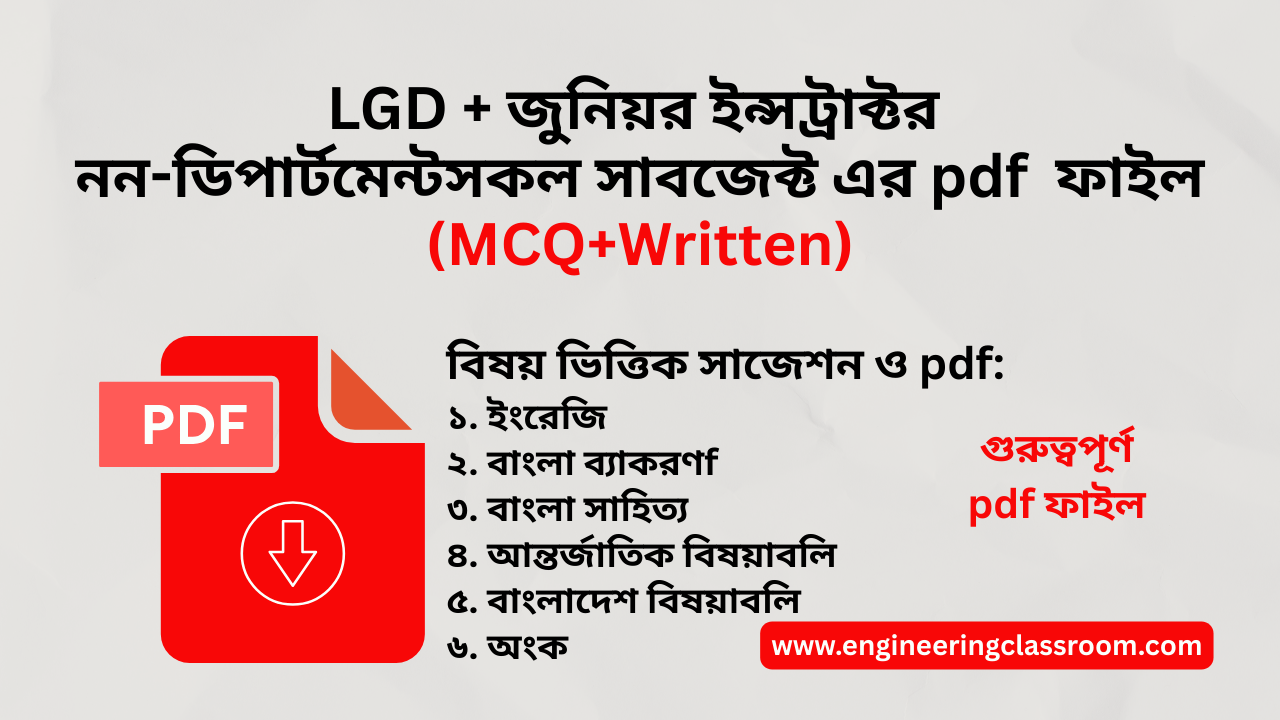MCQ
1661. The resultant of the following three couples 20 kg force, 0.5 m arm, + ve sense 30 kg force, 1 m arm - ve sense 40 kg force, 0.25 m arm, + ve sense having arm of 0.5 m will be-
20 kg. (-ve) sense
20 kg. (+ve) serse
10 kg. (+ve) sense
10 kg. (-ve) sense
Himalay Sen Sir
মেকানিক্যাল ইঞ্জিনিয়ারিং MCQ
mechanical mcq
মেকানিক্যাল বিগত সালের প্রশ্ন সমাধান
ইঞ্জিনিয়ারিং মেকানিক্স mcq
ব্যাখ্যা: 30 ×1+R x 0.5 – 40 × 0.25 =20 x 0.5
∴R = -20 kg
1662. Two non-collinear parallel equal forces acting in opposite direction-
balance each other
constitute a moment
constitute a couple
constitute a moment of couple
1663. The forces, which meet at one point, but their lines of action do not lie in a plane, are called-
coplanar non-concurrent forces
non-coplanar concurrent forces
non-coplanar non-concurrent forces
intersecting forces
1664. Which one is vector?
work
energy
speed
force
Himalay Sen Sir
মেকানিক্যাল ইঞ্জিনিয়ারিং MCQ
mechanical mcq
মেকানিক্যাল বিগত সালের প্রশ্ন সমাধান
ইঞ্জিনিয়ারিং মেকানিক্স mcq
ব্যাখ্যা: ভেক্টর রাশি (Vector quantity) : যে-সব ভৌত রাশির মান ও দিক উভয়ই আছে, তাদের ভেক্টর রাশি বলে। উদাহরণ সরণ, ওজন, বেগ, বল ও ত্বরণ ইত্যাদি।
স্কেলার রাশি (Scalar quantity): যে-সব ভৌত রাশির কেবলমাত্র মান আছে, কিন্তু কোন দিক বা অভিমুখ নেই। সেইসব রাশিকে স্কেলার রাশি বলে। উদাহরণ- দৈর্ঘ্য, প্রস্থ, ক্ষেত্রফল, উচ্চতা, তর ও সময় ইত্যাদি।
1665. Which of the following is not a scalar quantity?
Time
Mass
Volume
Acceleration
1666. If a number of forces act simultaneously on a particle, it is possible-
not a replace them by a single force
to replace them by a single force
to replace them by a single force through CG
to replace them by a couple
1667. পুলির প্রথম পদ্ধতির জন্য ভেলোসিটি রেশিও –
n
n²
2^n
2^n -1
1668. Which of the following is the vector quantity?
Angular displacement
Angular velocity
Angular acceleration
All of these
1669. The resultant of two force P & Q Such that P >Q) acting along the same straight line but in opposite direction is given by-
P+Q
P-Q
P/Q
Q/P
1670. Two force P and working in the same direction. Then the total force is
P+Q
R
P-Q
P/Q
1671. According to Lami's theorem-
three forces acting at a point will be in equilibrium
three forces acting at a point can be represented by a triangle, each side being proportional to force
if three forces acting upon a particle are represented in magnitude and direction by the sides of a triangle, taken in order, they will be in equilibrium
if three forces acting at a point are in equilibrium, each force is proportional to the sine of the angle between the other two
1672. Which of the following is a scalar quantity?
Velocity
acceleration
volume
force
1673. The resultant of two forces P and Q acting at an angle is
√P ² + Q ² + 2PQ sinθ
√P ² + Q ² + 2PQcosθ
√P ² + Q ² -2PQ sinθ
√P ² + Q ²- 2PQcosθ
1674. Which of the following is not a vertor quantity?
Weight
Velocity
Acceleration
Force
1675. The unit of force in SI system of units is-
Dyne
Kilogram
Newtch
Watt
1676. একটি ফ্রেম স্ট্রাকচার সঠিক হবে, যবাহুসংখ্যা (2j - 3) এর……
সমান
কম
বেশি
কোনটিই নয়
1677. A single force and a couple acting in the same plane upon a rigid body-
balance each other
cannot balance each other
produce moment of a couple
are equivalent
1678. A weight 'W' kg rest on a spring of spring constant K= 8kg/cm. The deflection of the spring due to weight is 4cm. The weight 'W' is-
16kg
32kg
64kg
128kg
Himalay Sen Sir
মেকানিক্যাল ইঞ্জিনিয়ারিং MCQ
mechanical mcq
মেকানিক্যাল বিগত সালের প্রশ্ন সমাধান
ইঞ্জিনিয়ারিং মেকানিক্স mcq
ব্যাখ্যা: W = δk
= 4 x 8
= 32kg
এখানে,
δ = 4cm
K= δ.kg/cm
1679. If three forces acting in different planes can be represented by a triangle, these will be in-
non-equilibrium
partial equilibrium
full equilibrium
unpredictable
1680. 1kg force equal-
1.02N
9.8 niec
9.8N
1.2N
















